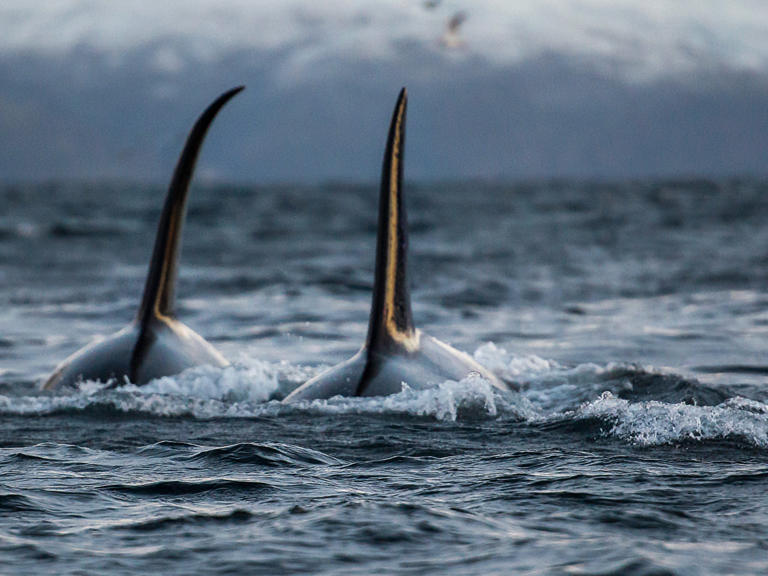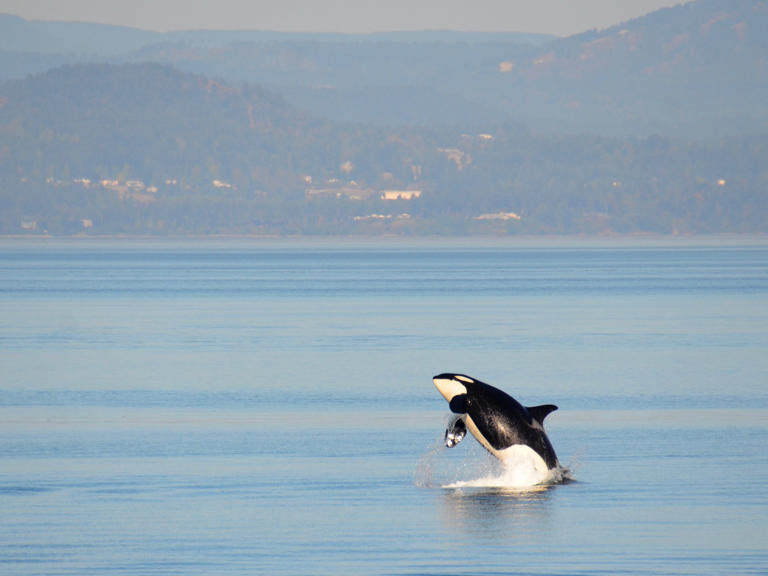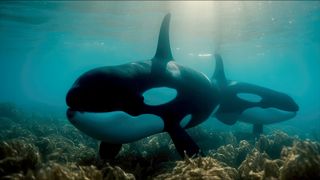Killer whales attack sailboats during race: "Scary moment"

Kerry Breen
Fri, June 23, 2023
Two sailing teams competing in a round-the-world race had a scary encounter with a pod of orcas on Thursday afternoon, race officials said.
The two teams are competing as part of The Ocean Race, an international competition that also works to gather climate data. The race has seven stretches across the world, but the two boats who encountered the killer whales are participating in a smaller three-leg version of the competition, called The Ocean Race VO65 Sprint.
One boat was crewed by Team JAJO, a group from Amsterdam. The other is crewed by Mirpuri Trifork Racing, a team from Portugal. The boats were traveling through the Atlantic Ocean to the west of Gibraltar when the encounter happened at around 2:50 local time, the organization said in a news release.

An orca interacts with a boat in The Ocean Race.
Jelmar van Beek, skipper of the JAJO Team, reported that there were multiple orcas involved. Both teams said that there was no damage to the boats and reported there were no injuries, but said the orcas had pushed up against the boat and nudged and bitten at the rudders. In one case, an orca rammed the boat.
"20 minutes ago we got hit by some orcas," said Team JAJO skipper Jelmer van Beek in a news release. "Three orcas came straight at us and started hitting the rudders. Impressive to see the orcas, beautiful animals, but also a dangerous moment for us as a team. We took down the sails and slowed down the boat as quickly as possible and luckily after a few attacks they went away… This was a scary moment."
The incident comes amid reports of seemingly coordinated attacks on boats by orcas. Multiple such incidents have been reported around Gibraltar, which neighbors Spain. Incidents where orcas have worked individually or in a pod to ram a boat's hull or rudders have tripled in the past two years, researchers have said, but it's not clear why. Between July and November 2020, there were 52 such interactions recorded by GTOA, a group that studies orcas in the Gibraltar area. In 2022, there were 207 such interactions. In at least three cases, the damage has resulted in sinking, The Ocean Race said.
A boat captain who was attacked twice by orcas, once in 2020 and once in 2022, told Newsweek that the whales seemed to have a plan.
"First time, we could hear them communicating under the boat," he told Newsweek. "This time, they were quiet, and it didn't take them that long to destroy both rudders. ... Looks like they knew exactly what they are doing. They didn't touch anything else."
Hilary Hanson
Thu, June 22, 2023
A man sailing a yacht in the North Sea near Scotland’s Shetland Islands said that an orca repeatedly rammed into his boat earlier this week, exhibiting behavior that’s been recently seen in killer whales farther south.
Retired Dutch physicist Dr. Wim Rutten was alone on a 7-ton yacht on Monday when an orca smacked into the boat’s stern, then circled back to hit it again and again “at fast speed,” he told The Guardian.

An orca seen off the coast of California.
The published Guardian interview did not mention any permanent damage to the vessel, just “soft shocks” felt through the hull.
“Maybe he just wanted to play,” Rutten, who was mackerel fishing when the orca showed up, speculated. “Or look me in the eyes. Or to get rid of the fishing line.”
His account bore a striking similarity to dozens of incidents reported this year in waters near Portugal and Spain. Last month, orcas broke the rudder and pierced the hull of a sailing boat near the coast of southern Spain, necessitating a rescue team to tow the vessel to a port. Three weeks prior, also off the Spanish coast, an orca trio rammed into and ultimately sank a yacht. No human deaths have occurred in any of the reported incidents.
Dr. Alfredo López Fernandez, a biologist who authored a paper published last year on the phenomenon, believes the incidents originated with a female orca known to scientists as White Gladis. The theory goes that White Gladis had a traumatic encounter involving a boat and started to behave defensively against other boats, and her fellow orcas picked up the behavior.
Not all scientists agree that’s what likely happened, though.
“What I think is probably happening is it’s a playful behavior. It’s a social behavior,” Dr. Deborah Giles, science director at research and advocacy group Wild Orca, told Vice News.
Giles suspects a young orca started playfully ramming boats, and others followed suit.
Aside from the behavior’s origin, another question is whether it’s now spreading to northern waters or is arising there independently.
Orca researcher Dr. Conor Ryan told The Guardian that it’s plausible that “highly mobile” orca pods are spreading the behavior northward.
“It’s possible that this ‘fad’ is leapfrogging through the various pods/communities,” he said.
The incidents have inspired a huge amount of largely supportive jokes and memes about an orca uprising. But Monica Bacchus, marine programs coordinator at National Fish and Wildlife Foundation’s Killer Whale Research and Conservation Program, told Vice that she doesn’t think what’s happening is an actual cetacean revolution. But she does find the phenomenon intriguing.
She said, “It’s always cool to see animals do new things.”
Joe Pinkstone
Wed, June 21, 2023

An orca pod off the coast of Scotland that may be the one that attacked a lone sailor off Shetland - Killer Whales / Orca Pod
A killer whale has repeatedly rammed a yacht off the coast of Scotland, it has emerged, in an attack reminiscent of those seen 3,000 miles further south near Gibraltar.
The orca is said to have made contact with a small boat off the Shetland coast in the North sea as a solo sailor embarked on a trip from Lerwick to Bergen, Norway.
Dr Wim Rutten, 72, is a retired scientist and told The Guardian he saw the whale come up through the water and repeatedly, and deliberately, collide with his boat. The most frightening aspect of the ordeal, he claims, was not the several shocks from the impacts but the “very loud breathing of the animal”.
He claims the orca was “looking for the keel” after its initial barrage before vanishing back into the water before mounting numerous follow-up attacks afterwards and circling the seven-tonne yacht. “Maybe he just wanted to play. Or look me in the eyes. Or to get rid of the fishing line,” he told the newspaper.
The reported attack in British waters comes after several tales of orcas attacking boats around Gibraltar and the Iberian peninsula.

A pair of orcas about to ram the stern of a boat - BNPS
Orcas are highly intelligent social creatures that live in pods and are capable of communicating with each other to share information. They hunt in coordinated movements with specific tactics but the reasoning for the attacks on boats remains unknown.
Some scientists have posited that this behaviour is merely young, adolescent killer whales playing, while others think they hone in on boats with a fishing line attached, as Dr Rutten had while hoping to hook a mackerel on his trip.
However, the apparent focus on the rudders of boats has led some experts to suggest the attacks are a deliberate technique learnt over time to disable the boat.
The Scottish attack has raised questions over how and why an orca is engaging with boats so far north. Although killer whales are often seen around northern Scotland, they are a completely different group and pod to their counterparts around Gibraltar that made headlines earlier this year for their assaults.
“It’s possible that this ‘fad’ is leapfrogging through the various pods/communities,” Dr Conor Ryan, a scientific adviser to the Hebridean Whale and Dolphin Trust, told The Guardian. He added that some pods are particularly mobile and they may have spread this information 3,000 miles from the mouth of the Mediterranean to Shetland’s waters.
Gladis, a particularly vindictive killer whale in the Gibraltar Strait, is thought to be teaching other members of her species how to attack yachts. It is thought Gladis is enacting her revenge on various yachts after a previous collision with a boat, or perhaps a scarring encounter with illegal fishing nets.

During the attacks the orcas always appear to be targeting the rudder of the boat, as if to disable it - BNPS
The matriarch has now educated the rest of her pod and they are now also thought to be ramming vessels with the aim of sinking them.
On May 2, six of the apex predators slammed into the hull of a Bavaria 46 yacht, which was sailing in the Strait of Gibraltar, near Tangier in Morocco. The hour-long attack left Cambridge couple Janet Morris, 58, a business consultant, and Stephen Bidwell, 58, a photographer, who were on board for a sailing course, in awe.
Mr Bidwell told The Telegraph it was “daunting” and added there was “a clearly larger matriarch” seemingly supervising the attack, which may have been Gladis. The trend towards targeting boats has led to sailors making adaptations to their boats in an attempt to protect themselves.
Bags of sand are now being carried aboard after hundreds of boats were damaged in the Strait and three sunk in the last three years, normally through headbutting the rudder to its destruction. Sand, when sprinkled in the water pre- or mid-attack, is said to confuse the cetacean sonar system and a few kilograms dropped overboard to create an “acoustic mirror effect”.

Frank Landymore
Thu, June 22, 2023
Things Go North
An orca repeatedly slammed into a yacht sailing in the North Sea off the coast of Scotland earlier this week, marking the first orca attack in northern waters.
In other words, the recent onslaught of orca attacks on ships, it seems, could be spreading.
"What I felt [was] most frightening was the very loud breathing of the animal," Wim Rutten, a retired Dutch physicist who was captaining the ship, told The Guardian.
The orca rammed the boat over and over, sending "soft shocks" through the hull. Once it stopped its assault, the whale dropped back and ominously trailed the vessel, "looking for the keel."
The whale "disappeared," Rutten described, "but came back at fast speed, twice or thrice… and circled a bit."
Attacking Spree
Killer whales have been terrorizing sailors for over a month. But until now, most if not all of the dozens of recent orca attacks on boats have been roughly contained to the seas south of Spain, in an area known as the Strait of Gibraltar.
Recently released footage shows an orca slamming into a sailboat off Spain's southern coast, damaging the hull and forcing sailors to pump water out of the boat.
The behavior is as unusual as it is terrifying. Until aggressive encounters were first documented back in 2020, orcas had been rarely known to approach, let alone attack, humans or their vessels. It was only in recent months that those burgeoning encounters escalated to sinking ships.
Orcas, like many whales, are incredibly social and intelligent creatures. Scientists suspect that the behavior is being taught by adults to their pods, and then spreading. The behavior moving from the Strait of Gibraltar all the way north of Scotland is quite a stretch, but some scientists say it's entirely possible.
"I'd be reluctant to say it cannot be learned from [the southern population]," Conor Ryan, a marine biologist and a scientist advisor for the Hebridean Whale and Dolphin Trust, told The Guardian.
"It's possible that this 'fad' is leapfrogging through the various pods/communities."
Just a Phase
As for the origin of the orca behavior and the intentions behind it, scientists have several theories. It could be that this is just an apex predator's idea of having fun. Rutten himself said it was possible the orca "just wanted to play."
Another prevailing theory is that this originated as an act of revenge, but some experts dispute this thinking.
As Ryan alluded to earlier, this could simply be a behavioral "fad." How long it will stay in fashion, though, remains to be seen.
More on orcas: Captain Attacked Twice by Orcas Says They're Developing Better Anti-Boat Strategies




